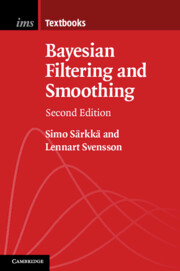Refine search
Actions for selected content:
2703 results in General statistics and probability
15 - Particle Smoothing
-
- Book:
- Bayesian Filtering and Smoothing
- Published online:
- 01 June 2023
- Print publication:
- 15 June 2023, pp 308-318
-
- Chapter
- Export citation
9 - Gaussian Filtering by Enabling Approximations
-
- Book:
- Bayesian Filtering and Smoothing
- Published online:
- 01 June 2023
- Print publication:
- 15 June 2023, pp 168-203
-
- Chapter
- Export citation
Preface
-
- Book:
- Bayesian Filtering and Smoothing
- Published online:
- 01 June 2023
- Print publication:
- 15 June 2023, pp xi-xiv
-
- Chapter
- Export citation
11 - Particle Filtering
-
- Book:
- Bayesian Filtering and Smoothing
- Published online:
- 01 June 2023
- Print publication:
- 15 June 2023, pp 229-252
-
- Chapter
- Export citation

Bayesian Filtering and Smoothing
-
- Published online:
- 01 June 2023
- Print publication:
- 15 June 2023
10 - Model Estimation and Types of Data
- from Part IV - Model Construction and Evaluation
-
- Book:
- Nonlife Actuarial Models
- Published online:
- 07 July 2023
- Print publication:
- 25 May 2023, pp 255-273
-
- Chapter
- Export citation
17 - Ratemaking
- from Part V - Loss Reserving and Ratemaking
-
- Book:
- Nonlife Actuarial Models
- Published online:
- 07 July 2023
- Print publication:
- 25 May 2023, pp 448-475
-
- Chapter
- Export citation
3 - Aggregate-Loss Models
- from Part I - Loss Models
-
- Book:
- Nonlife Actuarial Models
- Published online:
- 07 July 2023
- Print publication:
- 25 May 2023, pp 77-102
-
- Chapter
- Export citation
Appendix: Review of Statistics
-
- Book:
- Nonlife Actuarial Models
- Published online:
- 07 July 2023
- Print publication:
- 25 May 2023, pp 476-509
-
- Chapter
- Export citation
13 - Model Evaluation and Selection
- from Part IV - Model Construction and Evaluation
-
- Book:
- Nonlife Actuarial Models
- Published online:
- 07 July 2023
- Print publication:
- 25 May 2023, pp 350-369
-
- Chapter
- Export citation
Contents
-
- Book:
- Nonlife Actuarial Models
- Published online:
- 07 July 2023
- Print publication:
- 25 May 2023, pp v-ix
-
- Chapter
- Export citation
Part III - Credibility
-
- Book:
- Nonlife Actuarial Models
- Published online:
- 07 July 2023
- Print publication:
- 25 May 2023, pp 147-252
-
- Chapter
- Export citation
2 - Claim-Severity Distribution
- from Part I - Loss Models
-
- Book:
- Nonlife Actuarial Models
- Published online:
- 07 July 2023
- Print publication:
- 25 May 2023, pp 37-76
-
- Chapter
- Export citation
8 - Bayesian Approach
- from Part III - Credibility
-
- Book:
- Nonlife Actuarial Models
- Published online:
- 07 July 2023
- Print publication:
- 25 May 2023, pp 199-227
-
- Chapter
- Export citation
1 - Claim-Frequency Distribution
- from Part I - Loss Models
-
- Book:
- Nonlife Actuarial Models
- Published online:
- 07 July 2023
- Print publication:
- 25 May 2023, pp 3-36
-
- Chapter
- Export citation
5 - Ruin Theory
- from Part II - Risk and Ruin
-
- Book:
- Nonlife Actuarial Models
- Published online:
- 07 July 2023
- Print publication:
- 25 May 2023, pp 131-146
-
- Chapter
- Export citation
16 - Loss Reserving
- from Part V - Loss Reserving and Ratemaking
-
- Book:
- Nonlife Actuarial Models
- Published online:
- 07 July 2023
- Print publication:
- 25 May 2023, pp 421-447
-
- Chapter
- Export citation
9 - Empirical Implementation of Credibility
- from Part III - Credibility
-
- Book:
- Nonlife Actuarial Models
- Published online:
- 07 July 2023
- Print publication:
- 25 May 2023, pp 228-252
-
- Chapter
- Export citation
Answers to Exercises
-
- Book:
- Nonlife Actuarial Models
- Published online:
- 07 July 2023
- Print publication:
- 25 May 2023, pp 510-529
-
- Chapter
- Export citation
7 - Bühlmann Credibility
- from Part III - Credibility
-
- Book:
- Nonlife Actuarial Models
- Published online:
- 07 July 2023
- Print publication:
- 25 May 2023, pp 169-198
-
- Chapter
- Export citation
